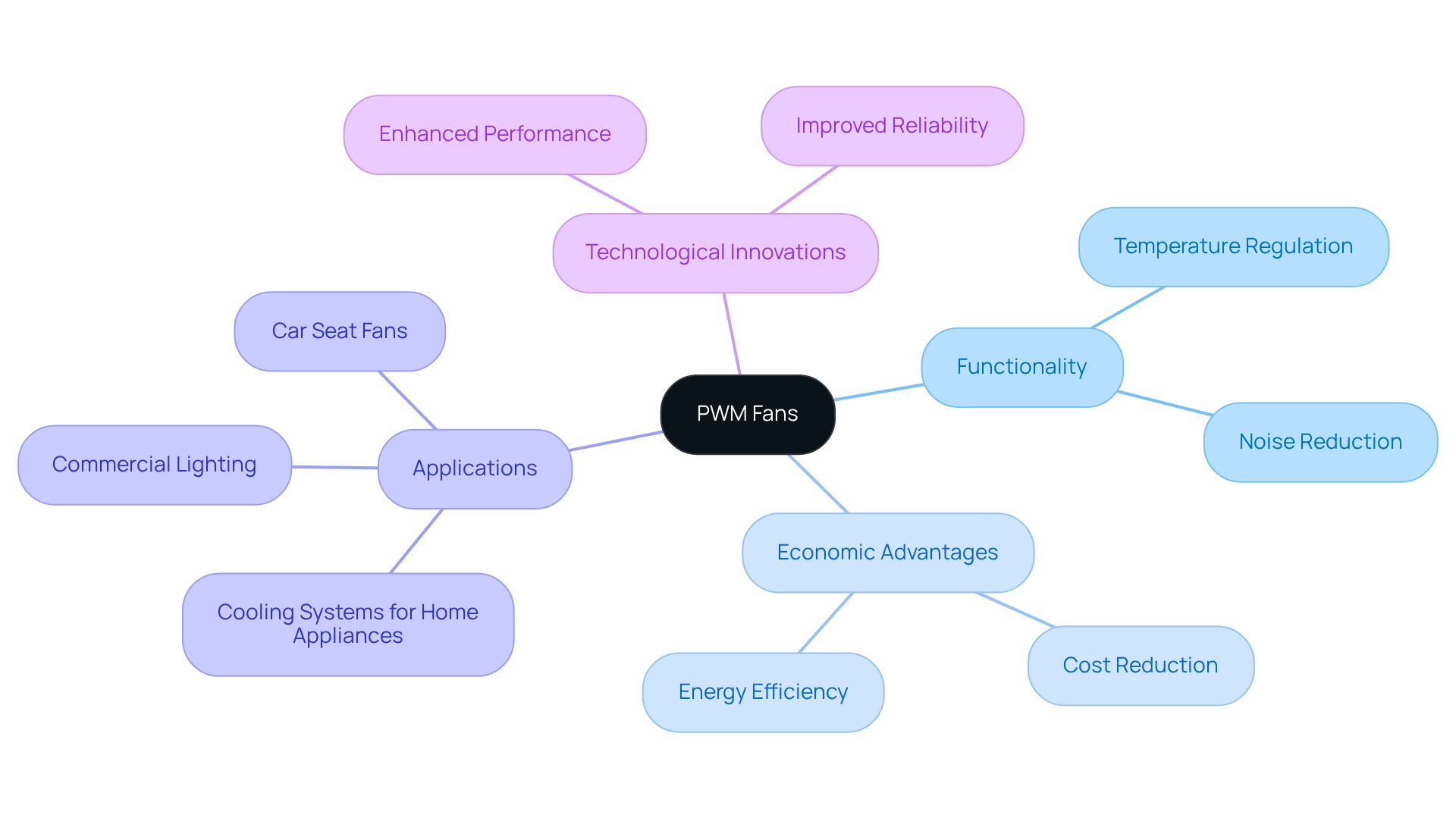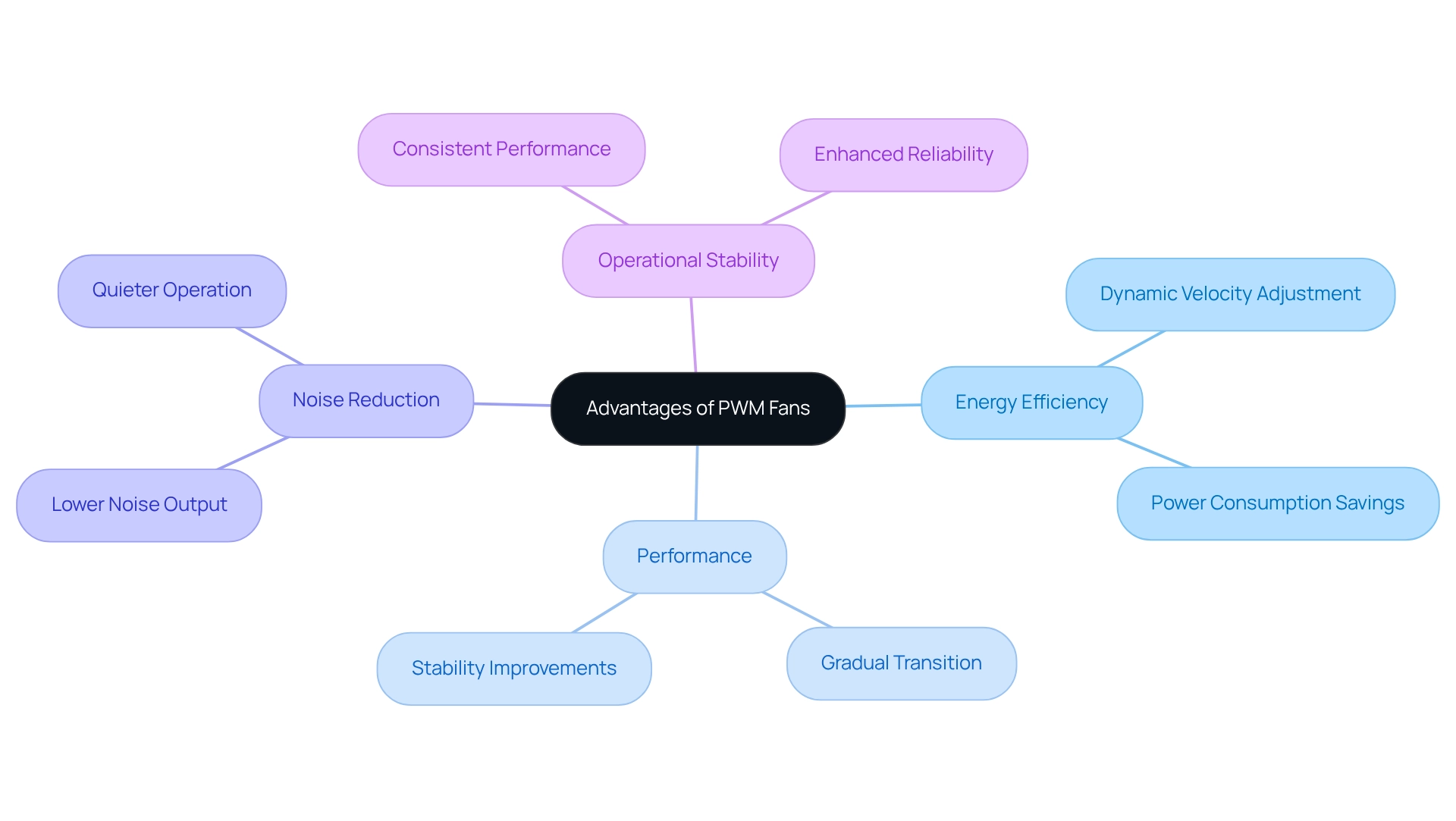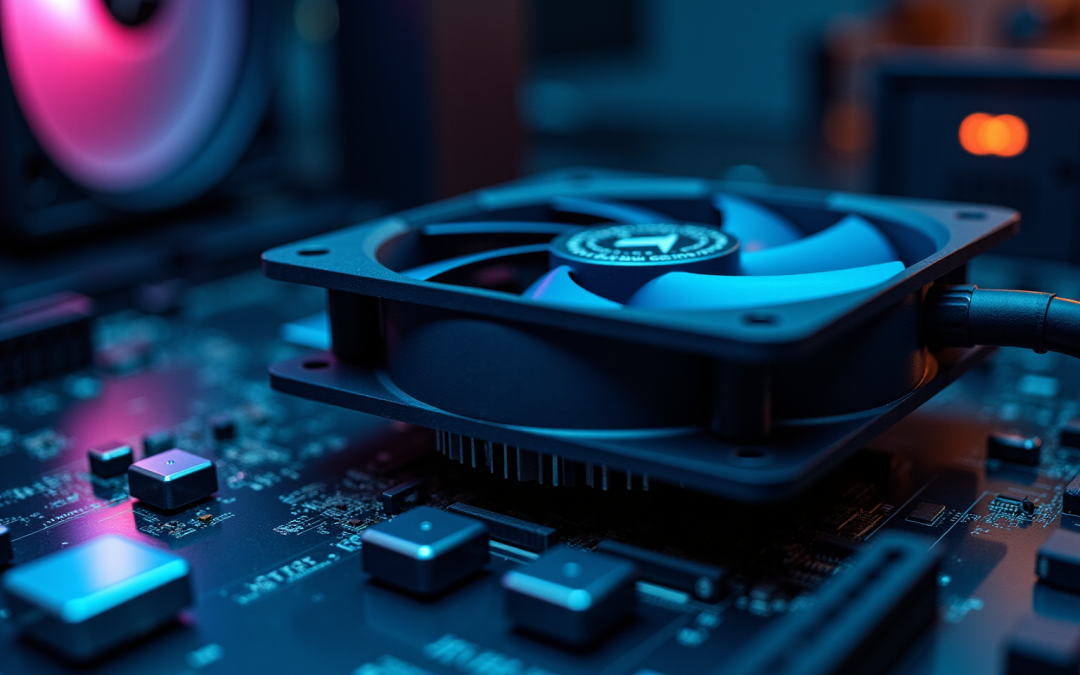Overview
PWM fans represent cutting-edge cooling solutions that leverage Pulse Width Modulation to dynamically regulate their speed in response to the thermal demands of electronic systems. This technology not only enhances energy efficiency but also significantly reduces noise levels.
The article elucidates how PWM technology facilitates precise control over fan operation, leading to substantial energy savings and improved performance across a spectrum of applications, such as personal computers and industrial machinery.
By implementing PWM fans, users can achieve optimized cooling solutions that align with both performance and environmental considerations.
Introduction
In the realm of modern electronics, the quest for efficient cooling solutions has led to the emergence of PWM fans, or Pulse Width Modulation fans. These innovative devices distinguish themselves from traditional fans by dynamically adjusting their speed in response to the specific thermal requirements of the system. This capability not only enhances energy efficiency but also significantly reduces noise levels.
As technology advances, the demand for PWM fans is surging across various sectors, from personal computing to industrial applications, underscoring their critical role in maintaining optimal performance and prolonging the lifespan of electronic components.
A closer examination of their functionality, operational mechanisms, and diverse applications reveals that PWM fans are not merely a trend; they are a fundamental component in the pursuit of smarter, quieter, and more efficient electronic systems.
Define PWM Fans: Functionality and Importance in Electronics
PWM units, or Pulse Width Modulation units, are an that dynamically modifies performance based on the thermal needs of electronic systems. Unlike conventional models that operate at a constant rate, PWM units utilize a 4-pin connector, with the fourth pin transmitting a PWM signal, enabling precise regulation of operation. This adaptability not only enhances but also significantly reduces noise levels, making indispensable in various electronic applications, particularly in computers and devices that generate substantial heat. The growing market for is driven by an increasing across multiple sectors. Recent statistics reveal that implementing can lead to a significant reduction in total operating costs for projects, highlighting their economic advantages. Additionally, the latest advancements in showcase innovations aimed at enhancing performance and reliability, ensuring that these devices align with the evolving requirements of the electronics industry.
Key functionalities of PWM systems include their capacity to maintain optimal operating temperatures, which is vital for the longevity and efficiency of electronic components. Case studies demonstrate their effectiveness in diverse applications, such as and commercial lighting, where they have played a crucial role in boosting performance and energy savings. Experts in the field emphasize the importance of PWM devices in modern electronics, noting that their integration can lead to and user comfort.

Explain How PWM Fans Operate: Technical Insights and Mechanisms
PWM fans operate using a technique known as pulse width modulation (PWM), which involves rapidly turning the fan on and off. The fan’s speed is regulated by adjusting the width of the ‘on’ pulses relative to the ‘off’ pulses. For instance, if the fan receives a signal that is ‘on’ for 30% of the time and ‘off’ for 70%, it will operate at approximately 30% of its maximum capacity. This method allows for more compared to conventional DC units, which typically adjust speed by altering voltage. The PWM signal is generated by the motherboard or a fan controller, ensuring efficient operation according to the system’s .
The significance of is highlighted by their widespread application in both personal computers and industrial environments, where reliable cooling and are paramount. Advancements in temperature regulation technologies have further enhanced the capabilities of , enabling engineers to create solutions that are both functional and visually appealing. As noted by an expert, “For ,” illustrating the versatility PWM devices offer across various cooling scenarios. A case study on the practical applications of PWM devices emphasizes their crucial role in achieving effective in modern electronic systems, demonstrating their importance in maintaining optimal performance and prolonging the lifespan of electronic components.
Discuss Advantages of PWM Fans: Efficiency and Performance Benefits
devices offer numerous advantages over conventional models, especially regarding and performance. A prominent benefit is their capability to dynamically adjust velocity based on real-time thermal conditions, resulting in . For instance, during cooler operations, PWM devices can function at lower rates, which not only diminishes power consumption but also lowers noise output. This adaptability is crucial in where is paramount.
Moreover, PWM fan PCs facilitate more compared to their DC counterparts, which often experience abrupt airflow changes. This characteristic not only promotes but also enhances the stability of the setup. A case study illustrates that a can yield a 60% decrease in power consumption and a noise reduction of approximately 6 dB, highlighting the non-linear relationship between fan speed and operational metrics.
As engineers remain optimistic about advancements in PWM technology, the performance benefits of PWM fan PC devices become increasingly evident, positioning PWM fan PC as a superior choice for modern electronic configurations.

Explore Applications of PWM Fans: Versatility in Modern Electronics
are integral to a vast range of applications, particularly within the electronics and computing sectors. Their role is paramount in personal computers, servers, and gaming setups, where a is crucial for , maintaining optimal performance, and extending the lifespan of components.
Beyond computing, PWM devices find extensive use in industrial machinery, HVAC systems, and automotive applications, where precise is vital. The operational efficiency of these devices, combined with low noise levels, renders them especially suitable for environments that prioritize sound reduction, such as home theaters and office spaces.
As technology progresses, the demand for PWM devices is anticipated to increase, underscoring their significance in modern electronic configurations. Typically, PWM technology operates with duty cycle percentages ranging from 20% to 80%, facilitating that cater to specific operational requirements.
Recent case studies, including those focused on 5G thermal management strategies, highlight the necessity of to avert overheating and boost system efficiency. This trend illustrates the growing dependence on in both computing and industrial applications, ensuring their status as a crucial component in contemporary electronics.
As Edvard König, founder of EK, articulates, “We want to thank you for considering EK as your temperature control solutions provider,” underscoring the critical nature of effective temperature management. Moreover, aimed at optimizing setups and pioneering innovative strategies, demonstrating the industry’s commitment to enhancing PWM fan performance.
Conclusion
The exploration of PWM fans highlights their critical role in modern electronics, characterized by their ability to dynamically adjust speed based on thermal requirements. This functionality not only enhances energy efficiency but also minimizes noise, establishing PWM fans as essential components across various applications, from personal computing to industrial systems. The technical insights into their operation through pulse width modulation underscore the sophistication of these devices, showcasing their superiority over traditional fans, particularly in terms of performance and adaptability.
The numerous advantages of PWM fans—energy savings and smoother speed transitions—significantly contribute to their growing popularity. Case studies demonstrate the impact of reduced fan speeds on power consumption and noise levels, emphasizing their efficiency and making them a preferred choice in environments where performance and quiet operation are paramount. The versatility of PWM fans spans multiple sectors, including HVAC and automotive applications, illustrating their importance in achieving optimal thermal management.
In conclusion, PWM fans transcend mere technological trends; they signify a fundamental shift towards smarter, quieter, and more efficient electronic systems. As the demand for effective cooling solutions continues to escalate, the integration of PWM fans will be vital in maintaining performance and extending the lifespan of electronic components. Embracing this advanced cooling technology is essential for anyone aiming to optimize their electronic systems in today’s rapidly evolving technological landscape.
Frequently Asked Questions
What are PWM units?
PWM units, or Pulse Width Modulation units, are advanced cooling solutions that adjust their performance based on the thermal needs of electronic systems.
How do PWM units differ from conventional cooling models?
Unlike conventional models that operate at a constant rate, PWM units use a 4-pin connector with a fourth pin that transmits a PWM signal, allowing for precise regulation of their operation.
What are the benefits of using PWM units?
PWM units enhance energy efficiency, significantly reduce noise levels, and maintain optimal operating temperatures, which is crucial for the longevity and efficiency of electronic components.
In what applications are PWM fan PC units commonly used?
PWM fan PC units are indispensable in various electronic applications, particularly in computers and devices that generate substantial heat, as well as in cooling systems for home appliances and commercial lighting.
What is driving the market demand for PWM fan PC units?
The growing demand for efficient temperature regulation solutions across multiple sectors is driving the market for PWM fan PC units.
What are the economic advantages of implementing PWM speed control?
Implementing PWM speed control can lead to a significant reduction in total operating costs for projects, highlighting its economic benefits.
What recent advancements have been made in PWM technology?
Recent advancements in PWM technology focus on enhancing performance and reliability to meet the evolving requirements of the electronics industry.
How do experts view the importance of PWM devices in modern electronics?
Experts emphasize that the integration of PWM devices can lead to substantial improvements in operational efficiency and user comfort in modern electronics.

